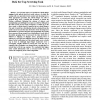Free Online Productivity Tools
i2Speak
i2Symbol
i2OCR
iTex2Img
iWeb2Print
iWeb2Shot
i2Type
iPdf2Split
iPdf2Merge
i2Bopomofo
i2Arabic
i2Style
i2Image
i2PDF
iLatex2Rtf
Sci2ools
ICRA
2009
IEEE
2009
IEEE
Trajectory generation of robotic fingers based on tri-axial tactile data for cap screwing task
In a previous paper, we developed a robotic finger equipped with optical three-axis tactile sensors, of which the sensing cell can separately detect normal and shearing forces. With appropriate precision, the robotic finger was able to perform three tasks: scanning flat specimens to obtain the friction coefficient, following the contour of objects, and manipulating a parallelepiped case put on a table by sliding it on the table. In the present study, designed as a follow-up to the above study, a robotic hand is composed of two robotic fingers. Not only tri-axial force distribution directly obtained from the tactile sensor but also the time derivative of the shearing force distribution are used for the hand control algorithm: if grasping force measured from normal force distribution is lower than a threshold, grasping force is increased; the time derivative is defined as slippage; if slippage arises, grasping force is enhanced to prevent fatal slippage between the finger and an object. ...
| Added | 19 Feb 2011 |
| Updated | 19 Feb 2011 |
| Type | Journal |
| Year | 2009 |
| Where | ICRA |
| Authors | Masahiro Ohka, Nobuyuki Morisawa, Hanafiah B. Yussof |
Comments (0)

